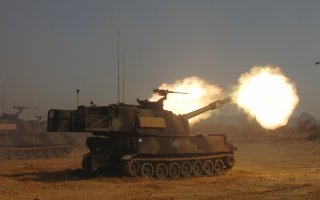Bad News: The U.S. Army’s Newest Big Gun Is Outranged by China and Russia
There clearly is still room for improvement.
Here's What You Need to Know: The new variant of the Paladin offers improved overall performance over its predecessor.
Last week, the U.S. Army hosted a live-fire demonstration of its upgraded M109A7 Paladin, which is set to replace the older M109A6 version of the self-propelled 155mm howitzer. The newly upgraded Paladin, which is produced by BAE Systems, provides increased combat capability and sustainment of the Army’s Armored Brigade Combat Teams.
“Say hello to the M109A7 Paladin, and the most recent addition to the GREYWOLF Family!,” the unit said in a tweet on the social media platform Twitter when it received the first of the new self-propelled howitzers in August. “The modernization efforts we make now, will enhance combat power within America’s #FIRSTTEAM, the U.S. Army, and entire Department of Defense during future large scale ground combat operations!”
The 2nd Battalion, 82nd Field Artillery, 3rd Armored Brigade Combat Team (ABCT), 1st Cavalry Division at Fort Hood was the first unit to receive the M109A7, and last week hosted a live fire demonstration. The U.S. Army Futures Command, the GREYWOLF brigade and more than fourteen high end civilian agencies attended the event to analyze the new Paladins and to explore ways to increase the firing rate of the new platform.
The new variant of the Paladin offers improved overall performance over its predecessor and has extended the maximum range by some 30 km with the Excalibur rocket-assisted projectile. However, it is still outranged by existing Russian and Chinese artillery systems.
There clearly is still room for improvement, and the Army Futures Command has turned to small business innovators to study and develop solutions to improve the rate of fire and performance of the M109A7, the latest howitzer in the company’s M109 family of vehicles. It remains the primary indirect fire support system for the U.S. ABCT. The Long-Range Precision Fires Team, project manager for the Self-Propelled Howitzer, and the Army Applications Lab also participated in the demonstration.
“This ties into what our brigade has already been doing, we are undergoing a huge modernization effort right now across the brigade,” said Capt. Stewart Tice, Bravo Battery Commander, 2-82 FA, according to Defence-Blog. “This battalion is fielding brand new A7 Paladins, along with new ammo supply vehicles, and in addition we just replaced our entire Humvee fleet with the new Joint Light Tactical Vehicle trucks.”
Enhanced Paladin
The M109A7 program was developed to enhance the reliability, maintainability, performance, responsiveness and lethality of the legacy M109A6 Paladin Self-Propelled Howitzer as well as the M992A2 Field Artillery Ammunition Support Vehicle’s (FAASV); while also providing increased commonality within the ABCT.
While the M109A7 entered full-rate production last year, the Army accepted delivery of the first low-rate initial production of the M109A7s in April 2014. In March, the Army also awarded BAE Systems a $339 million contract modification for the production of 48 vehicle sets of the vehicle and its companion, the M992A3 Carrier, Ammunition, Tracked (CAT) vehicle, and included post-delivery support and spare parts.
According to BAE Systems, the new M109A7 utilizes the existing main armament and cab structure of a Paladin M109A6, and replaces the vehicle’s chassis components with modem components common to the Bradley Fighting Vehicle. In addition, the improved chassis structure provides greater survivability and commonality with the existing systems in the ABCT, which BAE Systems said could reduce operational sustainability costs by replacing obsolete components.
The M109A7’s additional power generation capability was also designed to support an improved capacity for electric gun drives and rammers. The enhanced Paladin further incorporates a digital backbone architecture, on-board digital fire control system, and a sophisticated navigation system to provide firing data.
This may not be the final update of the Paladin platform. Last year an Army research project called for the development of an autonomous system could perform functions such as loading shells into cannons. As the Paladin has a crew of four—including a loader and gunner—such a robot-based system could reduce the number of soldiers who are assigned to each vehicle.
Peter Suciu is a Michigan-based writer who has contributed to more than four dozen magazines, newspapers and websites. He is the author of several books on military headgear including A Gallery of Military Headdress, which is available on Amazon.com.
This article first appeared earlier this year.
Image: Flickr / U.S. Army

